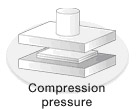
Pressure Distribution on a Lamination Press: Fuji Prescale as Diagnostics Tool
Keywords: Industrial hydraulic press servicing, laminated plywood quality testing, lamination press repair Summary: Lamination presses must distribute pressure throughout the lamination surface. Common defects like plate misalignment results in poor lamination quality. Fuji Prescale pressure sensitive films are the simplest and easiest way to diagnose the scope and location of the plate misalignment. Written by Igor MateskiLamination Press and Even Pressure Distribution
Lamination as a manufacturing process is widely used in various industries, starting from simple fishing rod manufacturing, to plywood manufacturing and electronics component manufacturing. In all these industries, the lamination press plays a crucial role.
To achieve high quality lamination products, the lamination press must be perfectly balanced/aligned, so that the press plates exert the same amount of pressure in every point of contact, throughout the pressing area.
This even pressure helps the lamination layers to properly bond, which in turn allows for even distribution of loads that the final product will be subjected to.
Misaligned press plates as prime reason for low lamination quality
With time, lamination presses deteriorate, and the key quality-related lamination press failure is the misalignment of the press plates. Namely, wear and tear of the top press plate guides and rails eventually leads to twisting, skewing or bending of the press surface.
When the geometry of the press plates is compromised, the lamination process gets distorted, and the laminated products are of low quality. Depending on the use of these products, a misalignment of the press plates can even lead to loss of lives.
This is why it is necessary for lamination presses to undergo regular maintenance checks where one of the primary functionality checkups is the pressure distribution between the press plates.
Fuji Prescale as the easiest way to measure scope and misalignment location
As illustration of the pressure distribution measurement using the Fuji Prescale pressure sensitive films, we will use a simple press with a single moving plate.
The top, moving pressure plate is guided along rails to keep it in perfect overlap with the bottom, fixed plate.
During the work life of the press, the two theoretically horizontal plates get misaligned and this small angle between the plates is the reason for poor quality of laminated products that the press produces.
The simplest, fastest and easiest way to measure the degree of misalignment, and pinpoint the defect, is to use a Fuji Prescale pressure sensitive film. Depending on the working pressure, you can pick the matching pressure sensitivity that is divided into 8 groups of Fuji Pressure Sensitivity, from ultra-low pressure to ultra high pressure sensitivity.
Theoretically, the contacting plates should be in perfect alignment, and ideally parallel to each other. But industrial machines suffer wear and rear, and in time, the pressure distribution can noticeably deviate from this perfect pressure profile.
For single-piston presses, the usual tear is concentric, namely, the greatest pressure is concentrated around the immediate area of the piston (not shown on image), and on the peripheral edges, the pressure is smaller
With two-pistons presses, one piston can exert more pressure than the other, and the lamination effectiveness is a gradient, as represented on the middle image.
For presses with four pistons, the pressure is greatest at the peripheral edges of the moving plate, while the pressure is smallest at the center, as represented in the right image.
Thanks to a quick pressure distribution test using the Fuji Prescale pressure sensitive films, you can quickly and acurately measure the pressure distribution between the two contacting surfaces. Using the FujiFilm Pressure Distribution Mapping Software (FDP-8010E) you can even scan the developed pressure sensitive film, and measure exactly the contacting pressure in any point. In this way, you can even evaluate the plate tear.


